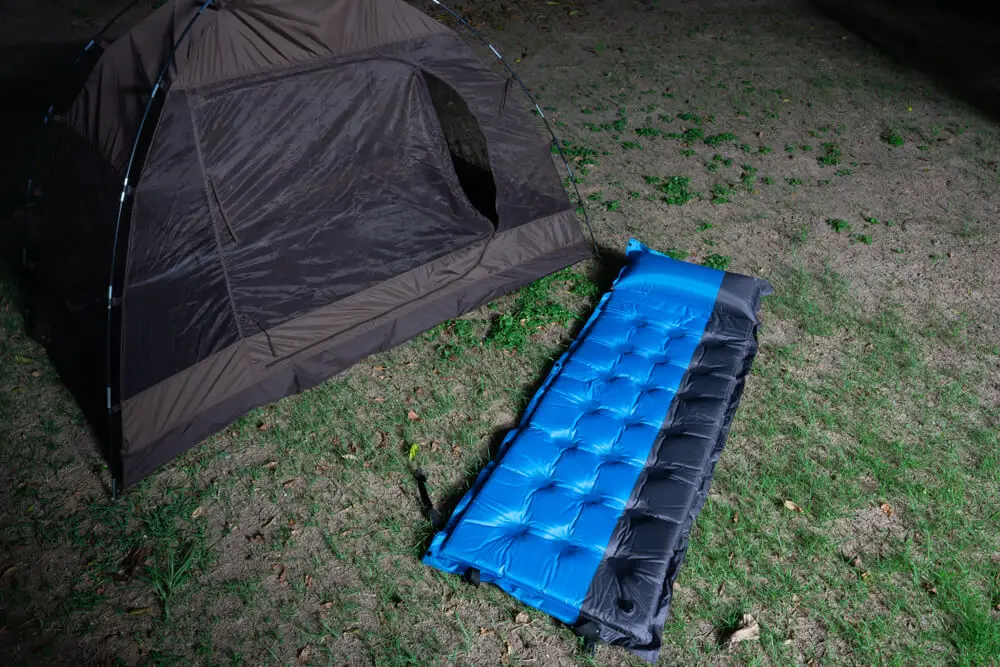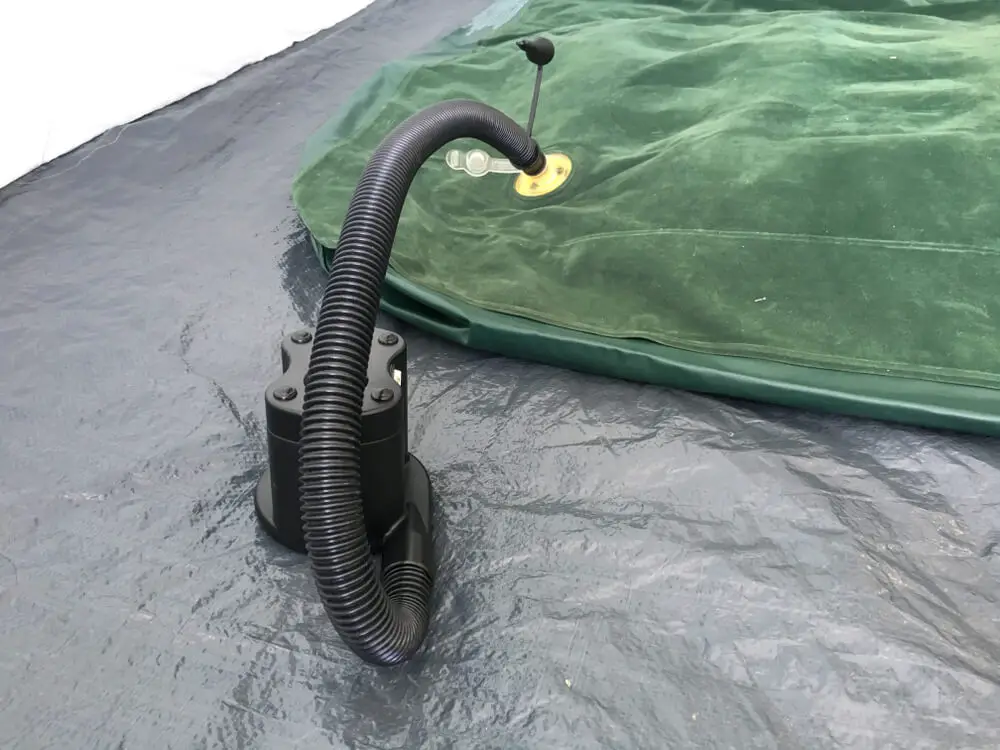Are you tired of uncomfortable sleeping arrangements while sleeping outdoors? If so, you might want to consider an alternative to an air mattress for camping.
Our list of tried-and-true options provides various comfort levels for sleepers, including:
- Sleeping pads: Lightweight and easy to carry
- Camping cots: Most bed-like, easy to set up
- Hammocks: Comfortable, light, lots of accessories
- Camping quilts: various levels of warmth available
- Sleeping bags: Easy to find, warm
- Foam toppers: Comes in different sizes and thicknesses
I’ve found that each of these lightweight options is viable if you need to hike to your camping spot. You’ll also find that each option works well for car camping and comes in varying sizes.
However, you’re probably wondering what some of the advantages and disadvantages are to taking an air mattress when you camp. Let's look at some of the common points in each category before we dive into the alternatives.
More...

Table of Contents
Pros of Air Mattresses
There is a reason many people take air mattresses camping with them, but some of the advantages of this item might not be immediately obvious.
1. Adjustable Firmness
The amount of air you pump into an air mattress directly affects how firm it becomes, and many people use this to their advantage to create a wonderfully cushioned surface. If you like a very firm mattress for sleeping, an air mattress is less than ideal.
2. Easy to Find
Many stores sell air mattresses, so this item is not hard to obtain. Not all air mattresses come with pumps, but you can usually buy those at the same store where you find an air mattress.
You can also find various air mattresses online at different price points and in different sizes to suit your needs.
3. Easily Stored
Air mattresses typically pack down to a relatively small size, and some even come with a storage bag. If you want to take an air mattress camping, it's easy enough to toss it in the trunk of your car, but it's not a good idea to store it there as the changing temperatures can degrade the material over time.
Cons of Air Mattresses
Now that we’ve covered the advantages of using an air mattress let's look at the disadvantages that cause many people to look for alternatives.
1. Air Loss
Air mattresses tend to lose air overnight as you use them, and you might not immediately notice until you’re resting on the ground. Most air mattresses are also notorious for small, pinhead-sized holes that are difficult to find and repair effectively.
If you use an air mattress for a prolonged time, you’ll likely need to inflate it every day. The older the air mattress is, the more likely you’ll experience air loss, and heavier individuals may see more substantial air loss in general.
2. Inflation Difficulties
Not all air mattresses come with an external pump or built-in pump, so you’ll need to purchase one separately. Without a pump, you have no other option but to inflate it by breathing into it, which is both labor-intensive, tiring, and time-consuming.
Even if you have a pump, you may have difficulty connecting it to the mattress in such a way that air doesn’t leak out as you inflate the mattress. These pumps are usually low quality, so pumps tend not to last much longer than the mattresses themselves.
3. Size and Weight
Not all air mattresses are lightweight, and some weigh far too much for an individual to carry far from the car. If you have to hike any distance to your campground, consider a lighter alternative than an air mattress, as these items often take up a bit of space as well.
4. Not Ideal for All Temperatures
In cold temperatures, an air mattress won’t perform as well, given that the plastic material tends to firm up and the valves shrink or expand depending on the ambient temperatures over a day.
The shrinking and expansion of the valves make it very likely that your mattress will lose air, but if the temperatures suddenly rise, you may find your air mattress overinflated. In general, having a bubble of cold air below you, such as an air mattress, is less than ideal in cold weather, but it can work ok in warmer temperatures.
5. Durability and Cost
Air mattresses aren’t known for their durability, and there seems to be a direct correlation between their quality and how much they cost. It's possible to get very cheap air mattresses at many department and chain stores, but these items do not last for years and are often uncomfortable.
I’m here to tell you that spending more money on an air mattress does not guarantee its quality, but it's a good start. The truth is, you’ll probably end up with a more comfortable air mattress overall. Higher-priced brands often feature unique construction that makes them more comfortable, durable, and easier to inflate, but user reviews often show mixed results.
6. Not Pet Friendly
An air mattress gets pierced easily by dog or cat claws under the right circumstances. Even sharp objects such as car keys or pencils can cause damage. Energetic pets jumping on your air mattress may also puncture it, and cloth-covered air mattresses are difficult to clean.
Parts that stick out from the air mattress, such as the valves or seams, aren’t bite or chew-proof and prove tempting to puppies and kittens alike.

6 Awesome Alternatives to Air Mattresses While Camping
Do you want a comfortable sleeping arrangement while camping? I’ve written out a list of alternatives so you can rest assured that an air mattress is not your only option. Let's cover six stellar alternatives that will help you sleep in a variety of camping situations.
#1 Sleeping Pads
Sleeping pads are a lightweight and efficient alternative to air mattresses for a lot of reasons, such as:
- Sleeping pads come in solid foam or inflatable designs
- Their design makes them less of a hassle to carry around than an air mattress
- They supply a decent amount of comfort
Look for thicker sleeping pads that come with carrying bags if you plan to hike to your campground, and remember to check the weight on a sleeping pad if you want to stick to ultralight gear.
The Big Agnes Air Core Ultra is my top pick in this category, but the Coleman Self-Inflating sleeping pad is also excellent.
Sleeping pads generally roll up for convenience and work in a wide variety of temperatures. These pads are also relatively easy to clean, and it's possible to get an inflatable one a few inches thick to keep side-sleepers comfortable.
Sleeping pads come with or without pillows attached, and the exterior fabric is easy to clean and sometimes waterproof. It's possible to get a decent sleeping pad for around $30 online, and there are even double versions for couples for individuals who need more space.
One drawback I’ve found to inflatable sleeping pads is that they can still leak air and get holes, but some of these pads come with built-in pumps for easy inflation. Many sleeping pads are self-inflatable, while others feature layers of foam for extra comfort.
Foam pads generally unroll ok for the most part, but some like to curl up and need to lay out for a bit to relax before they lay flat.
#2 Camping Cot
Camping cots have become more popular since they feel closer to an actual bed, but they aren’t ideal for backpacking unless you get an ultralight version.
When car camping, you’ll also love these features:
- A camping cot gets you off the cold ground
- Cots supply a comfortable base for your body, a sleeping bag, or a sleeping pad
- Cots are most similar to a bed
Most camping cots come with a piece of fabric stretched across the top, but a few feature built-in padding, so all you have to do is set them up and lay down when you’re ready to sleep. Brands like Coleman and Teton Sports offer several different options that pair well with other accessories.
Camping cots also come in bunk bed styles so you can sleep more people in certain types of tents. Certain camping conditions also lend themselves well to camping cots, and a camping cot can make a good guest bed in a pinch.
#3 Hammocks
Hammocks are a cheaper alternative to air mattresses and other types of bedding. As a bonus:
- They’re easy to take with you anywhere and set up between two trees or on a stand
- Some people report sleeping more deeply in a hammock for various reasons, with the gentle rocking reported as soothing.
- The accessories help you customize your sleep experience
In addition to the science that backs this up, it's also noteworthy that hammocks are easy to clean, and there’s a wide variety of accessories available so you can customize them to your needs.
Brands like Wise Owl and ENO are well known for their hammocks that come with accessories you might want to consider, such as:
- A portable hammock stand
- Underquilt
- Rainfly
- Bug net
- Organizers and gear slings
If you plan to sleep outside, a rainfly and bug net are bare essentials in most areas. It's possible to use blankets you already have to keep warm, or you can wear additional clothing. Many hammocks are lightweight, backpacking friendly, and can withstand lengthy camping trips.
Another advantage of hammocks is that when they get damaged, it's relatively easy to repair. It's also possible to upgrade or replace accessories as needed without having to get a new hammock.
#4 Camping Quilts
Many individuals who don’t sleep well in sleeping bags have switched to camping quilts which look like regular blankets. These quilts might have a foot pocket at one end, but many are rectangles of comfy insulation that you can sleep on top of when the temperatures rise.
Other pros I’ve also found include:
- It's possible to use a camping quilt with a sleeping pad
- The quilt adds additional warmth and padding but takes up little space and is lightweight
- Many individuals sleep on top of their camping quilt when it's warm enough
- Quilts provide just a little padding and layers well with other types of bedding like cots or sleeping pads
Camping quilts wash more easily than sleeping bags and often cost less. There is a range of camping quilt options available, from fancy technical fabrics to regular fleece. You can find quilts for all temperature ratings, and in a pinch, you can use a traditional blanket as a camping quilt.
Camping quilts come in multiple colors and pack down relatively small, so they’re easy to store. If you are looking for a lightweight alternative to an air mattress, a camping quilt is a viable option you can stash in your bag, car, or closet without causing damage to the quilt. I prefer brands such as Therm-a-Rest, and Sea to Summit.
#5 Sleeping Bags
Sleeping bags share many of the advantages of camping quilts, but they have a zipper and hood for your head that provides necessary warmth in colder conditions.
Unlike an air mattress, I also like these features you get with a sleeping bag:
- A sleeping bag keeps you warm even if you lay on top of it
- Sleeping bags don’t require inflation or any tools
- They pack down small for storage
- Sleeping bags come in different shapes, such as rectangular or mummy
I prefer to choose sleeping bags based on the insulation level best suited for various cold temperatures. You’ll pay more for a bag with a lower temperature rating or fancy technical fabric construction, but there are also cheaper alternatives.
Sleeping bags are a bit trickier to clean than a camping quilt but less involved than cleaning a whole air mattress. Sleeping bags also pack easily into a stuff sack so you can quickly put them in your bag, car, or closet.
I’ve often found single sleeping bags or double-wide sleeping bags relatively easily in stores, and unlike an air mattress, you won’t feel movement when the person next to you changes position.
Look for brands like Kelty and Mountain Hardware but know there are many great options available.
#6 Foam Toppers
Foam toppers as an alternative to air mattress for camping won’t deflate like an air mattress, but this also means they are much bulkier to transport.
Other pros include:
- Foam toppers tend to roll up relatively easily
- Feature lightweight materials
- Gel-infused designs limit heat build-up
A foam topper gets you off the ground enough that there’s a layer of insulation under you, but memory foam toppers may firm up in colder temperatures. A foam topper often takes up more space than a deflated air mattress, but they fit standard-sized sheets and require no inflation.
Foam toppers also pair well with other types of padding, such as sleeping pads or cots, but they won’t cover up the rocky or bumpy ground, so you’ll need a smooth base to start.
Another advantage to using a foam topper is that you can cut it to fit your sleeping space exactly, and for individuals sleeping in a car or van, you can layer it with another padding to get your desired firmness.
Top brands for foam toppers include Zinus, Lucid, and Sealy.
Warp-Up
Air mattresses are an efficient and comfortable sleeping base while camping. Still, alternatives like a camping cot are my preference as they offer bed-like comfort that combines well with other accessories for sleeping.
An air mattress or camping cot both have their drawbacks, but campers can combine cots with other alternatives on this list to craft their perfect sleep solution.
- Are Merrell Shoes Good? – An Unbiased Review of Merrell Footwear - December 9, 2023
- Where Are Merrell Shoes Made? - December 9, 2023
- Camping in 40-degree Weather: Tips and Tricks - September 25, 2023

![Camping Cots vs Air Mattresses [Which One To Choose?] Camping Cots vs Air Mattresses [Which One To Choose?]](https://grandcircletrails.com/wp-content/uploads/2022/06/Camping-Cots-vs-Air-Mattresses-150x150.jpg)
![How to Protect Yourself While Camping? [TOP Camping Safety Tips] How to Protect Yourself While Camping? [TOP Camping Safety Tips]](https://grandcircletrails.com/wp-content/uploads/2022/07/How-to-Protect-Yourself-While-Camping-1-150x150.jpg)
![Brands Like North Face [15 North Face Alternatives] Brands Like North Face [15 North Face Alternatives]](https://grandcircletrails.com/wp-content/uploads/2023/01/Brands-Like-North-Face--150x150.png)

![What to Put Under Air Mattress When Camping? [Detailed Guide] What to Put Under Air Mattress When Camping? [Detailed Guide]](https://grandcircletrails.com/wp-content/uploads/2022/06/What-to-Put-Under-Air-Mattress-When-Camping-150x150.jpg)
![Why is My Air Mattress Deflating but No Holes? [5 Possible Reasons] Why is My Air Mattress Deflating but No Holes? [5 Possible Reasons]](https://grandcircletrails.com/wp-content/uploads/2021/09/Why-is-My-Air-Mattress-Deflating-but-No-Holes-1-150x150.jpg)